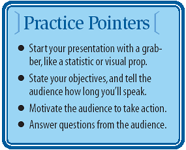Article
How to pack power and punch into your presentations
There's no better way, after physician referrals, to generate new patients than public speaking.

You pack up your computer and projector and leave, waiting for phone calls from new patients ready to make an appointment. No one calls. You do this a half-dozen times and conclude that public speaking is a waste of your time.
Wrong! There's no better way, after physician referrals, to generate new patients than public speaking. The key is to put a little pizzazz into those presentations. This article offers a few public-speaking techniques that will keep the phone ringing at your office.

Another grabber is to use a prop or a visual. If I am speaking on incontinence, I will use a yellow balloon and inflate and deflate it to demonstrate the storage and emptying functions of the bladder and the urethra.
Consider using a well-rehearsed joke or an example of self-effacing humor. Even if the joke fails to get a chuckle, it demonstrates that you aren't necessarily a lofty physician but really just like a member of the audience.
Hit them with facts Next, state your objectives and let them know why the topic is important. An example: "Erectile dysfunction or impotence is a common condition affecting thousands of men in this community. It affects not only the man but also his partner. During this 20-minute presentation I will discuss the causes of erectile dysfunction, the very simple evaluation, and what treatments are available so that no one needs to suffer the tragedy of the bedroom."
If you don't get a formal introduction, introduce yourself, describe your practice, state your credentials, and acknowledge the group by name. Also, let them know how long you'll speak. Present your material with only three or four points you want to make. Use anecdotes and success stories, and discuss the benefits of a particular treatment.
The windup
The close is just as important as the opening. This is when you motivate the audience to take action, ie, to pick up the phone and call your office for an appointment.
Start your close by letting the audience know you are about to conclude. I usually have a summary slide that includes my take-home messages. I start with: "I would like to conclude this presentation by emphasizing these three points." The closing comments are always connected to your opening goals and objectives.
Next, I move to the call to action. An example: "Urinary incontinence is a devastating condition that doesn't kill you but does steal your life. Help is available. Call your doctor. He or she will take your history, conduct an examination, and find a treatment for your problem of urinary in-continence." Then comes the punch or the zinger, for example: "You don't have to depend on Depends!"


